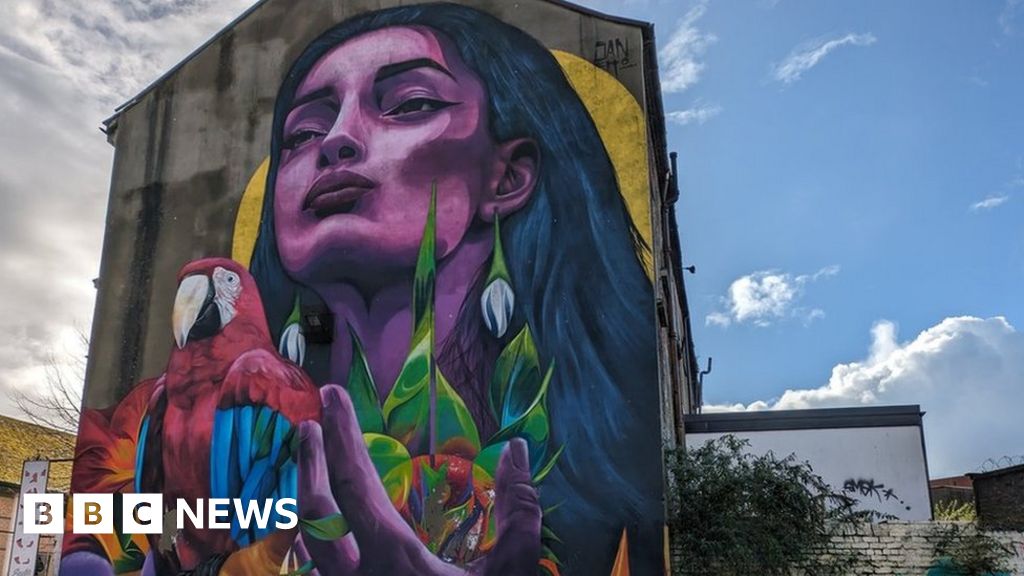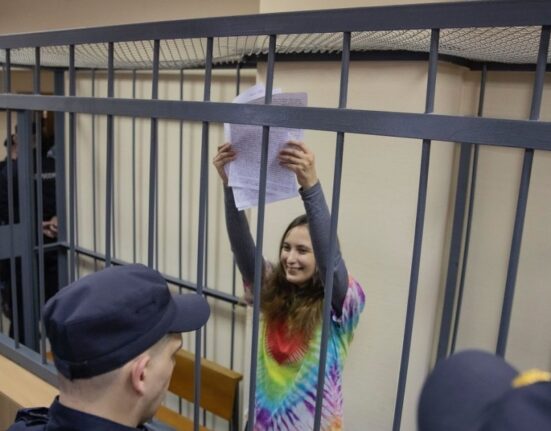Grey gable walls, such as this one on Union Street in Belfast, are much-sought-after canvases for street artists
Once considered the scourge of towns and cities, graffiti and street art are now making properties hot in Belfast.
Walk through parts of the city centre and its offshoots and you’ll see explosions of colour on gable walls, illuminating streets and alleys that were otherwise dark, drab and forgotten.
Now Belfast City Council has approved a plan to create legal “graffiti walls” to nurture those behind the street art boom.
The idea is to provide spaces in the city where people are allowed to practise their craft without having to worry about getting into trouble for it.
Image source, Hannah Constance
Hannah Constance says she wishes legal graffiti walls had been around when she was starting out
Hannah Constance, who has several pieces of street art in Belfast as well as in other cities across the UK, supports the plan.
“I’ve come from a graffiti background, that’s where I’ve learnt,” she tells BBC News NI.
“I would have wanted legal walls back when I was 16, 15 years ago – then I wouldn’t have gotten in trouble.”
Hannah has always wanted to paint on bigger canvases like walls but to do so can be prohibitively expensive.
Hannah’s artwork can be found across Belfast, including this piece on the Dublin Road
“As an artist you need to practice every day otherwise you’re not going to get anywhere.
“If you look at some of the best street artists in the world, they’re coming from cities in Europe that all have legal walls that they can go and practise and paint.”
She says young artists often approach her to ask where they can practice their art but she has never had a good answer for them so she’s delighted that could be about to change.
The eyes of huge portraits, such as this one on High Street Court in Belfast, seem to follow passers-by
“It’s going to bring a lot of positive change and it well help die down [illegal] tagging and graffiti because you’re giving people somewhere they can go and practice their styles without looking over their shoulder.”
‘You have to hone your art’
SDLP councillor Gary McKeown, who put the proposal for legal graffiti walls to the council, says Belfast has had an “explosion in fantastic street art” over the past few years.
The impulse to create that is something that he and the council want to push “towards a positive outlet”.
“The city council, to be fair, has actually been at the vanguard of promoting this and has worked with creative artists across the city in developing really expectational pieces of street art,” he says.
Gary McKeown hopes legal graffiti walls will help to nurture the next generation of street art talent
“Not everybody is going to get given a massive gable wall off the bat – you have to develop skills and you have to hone your art.”
The councillor says that many of the details of the proposal, including where the walls will be, still need to be worked out by officials.
But he hopes that paint will be splashed on the first legal graffiti wall early in the new year – the selected locations will be “self-evident” and will probably already have a history street art, he says.
He also expects the move to lead to a reduction in what he calls “anti-social graffiti”.
The red-brick buildings on Union Street in Belfast are coloured by portraits, graphics and slogans
“We get regular constituency inquiries about tagging of public infrastructure and I know people get really frustrated by that.
“As a consequence of this plan we will hopefully reduce some of the nuisance tagging that tends to appear across the city.
“We would want to make sure if there are any issues around inappropriate stuff that’s being put around the walls that is managed… as it would be anyway with the council removing offensive graffiti around the city.”
‘It’s cheap and transformative’
Adam Turkington runs Seedhead Arts, a company offering street art tours and hosting events to promote the art form.
Gary McKeown says Belfast has been blessed with an “explosion in fantastic street art” in recent years
He believes that street art in Belfast is “making the city a better place to exist”.
“It highlights how art can, in a very tangible way, make people’s lives better,” he says.
Having worked in street art for more than 15 years, he’s noticed the scene grow massively in recent times.
This artwork, painted several years ago at Exchange Place, is one of many in Belfast’s Cathedral Quarter
“You would have seen it go from maybe two part-time street artists at best to probably north of 20 now and we’re starting to see artists moving to Belfast from other parts of the world to live here because the scene works.
“By and large, people realise that in terms of public art it’s remarkably cheap in comparison to, say, a sculpture and it can be utterly transformative.
“People sometimes ask me if I’m going to run out of walls and there’s no way – there’s so many horrible walls, it’s almost as if we don’t think about that in our city planning.”
Belfast has become a popular location for street artists from other parts of the world, says Adam Turkington
Legal graffiti walls will help to open up street art to a wider range of people, he believes.
“We have a really, really strong female scene in Belfast and one of the reasons why street art can be quite a male-dominated art form is that in order to get good at it you almost have to go down a dark alleyway somewhere and practise it.
“It’s basically allowing people who want to learn the skills a safe space to do so.”







